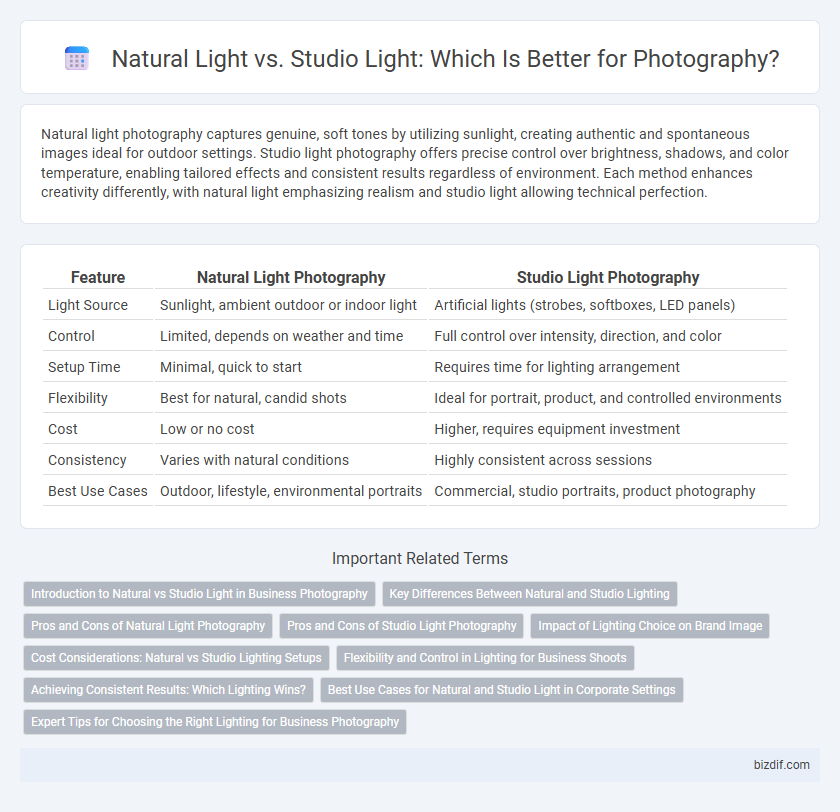Natural light photography captures genuine, soft tones by utilizing sunlight, creating authentic and spontaneous images ideal for outdoor settings. Studio light photography offers precise control over brightness, shadows, and color temperature, enabling tailored effects and consistent results regardless of environment. Each method enhances creativity differently, with natural light emphasizing realism and studio light allowing technical perfection.
Table of Comparison
| Feature | Natural Light Photography | Studio Light Photography |
|---|---|---|
| Light Source | Sunlight, ambient outdoor or indoor light | Artificial lights (strobes, softboxes, LED panels) |
| Control | Limited, depends on weather and time | Full control over intensity, direction, and color |
| Setup Time | Minimal, quick to start | Requires time for lighting arrangement |
| Flexibility | Best for natural, candid shots | Ideal for portrait, product, and controlled environments |
| Cost | Low or no cost | Higher, requires equipment investment |
| Consistency | Varies with natural conditions | Highly consistent across sessions |
| Best Use Cases | Outdoor, lifestyle, environmental portraits | Commercial, studio portraits, product photography |
Introduction to Natural vs Studio Light in Business Photography
Natural light photography in business settings leverages ambient sunlight to create authentic, vibrant images that convey a genuine atmosphere, ideal for outdoor shoots and corporate events. Studio light photography utilizes controlled artificial lighting, allowing precise manipulation of shadows, highlights, and color temperature, essential for product shots, headshots, and branding portraits. Choosing between natural and studio light impacts the visual tone, consistency, and professionalism expressed in business imagery.
Key Differences Between Natural and Studio Lighting
Natural light photography relies on sunlight, creating soft, dynamic shadows and a more organic feel, ideal for outdoor and candid shots. Studio light photography uses artificial lighting equipment such as strobes and softboxes, allowing precise control over intensity, direction, and color temperature for consistent results. Key differences include variability and quality of light, flexibility in timing, and the ability to manipulate shadows and highlights for desired effects.
Pros and Cons of Natural Light Photography
Natural light photography offers the advantage of cost-effectiveness and the ability to capture authentic, soft, and dynamic lighting that enhances natural skin tones and textures. However, it can be unpredictable due to weather conditions and time-of-day limitations, leading to inconsistent results. Photographers must adapt to changing light environments, which may require additional skills in timing and positioning to maximize the available sunlight.
Pros and Cons of Studio Light Photography
Studio light photography offers precise control over lighting conditions, enabling consistent and reproducible results ideal for portrait and product shoots. Its ability to manipulate light intensity, direction, and color temperature enhances creative possibilities but requires investment in equipment and space. However, studio settings can sometimes produce less natural-looking images compared to natural light, potentially resulting in a more staged appearance.
Impact of Lighting Choice on Brand Image
Natural light photography conveys authenticity and warmth, often enhancing a brand's image by evoking trust and relatability through soft, natural tones. Studio light photography offers precise control over illumination and shadow, enabling consistent brand aesthetics and a polished, professional appearance. Choosing between natural and studio lighting directly influences how a brand is perceived, shaping audience emotions and reinforcing its core values.
Cost Considerations: Natural vs Studio Lighting Setups
Natural light photography requires minimal investment, relying on available sunlight, making it ideal for budget-conscious photographers. Studio light photography demands significant expenditure on equipment like strobes, softboxes, and light meters, as well as ongoing costs for electricity and studio space rental. Understanding these cost differences is crucial for photographers deciding between a flexible, low-cost setup and a controlled, high-investment environment.
Flexibility and Control in Lighting for Business Shoots
Natural light photography offers unparalleled flexibility, enabling photographers to adapt quickly to changing environments and capture authentic, organic images that resonate with business clients seeking a natural aesthetic. Studio light photography provides precise control over every lighting element, allowing for consistent, high-quality results and the ability to manipulate shadows, highlights, and color temperature essential for professional branding and product shoots. Balancing natural and studio lighting techniques enhances creative possibilities, ensuring tailored visuals that meet diverse commercial objectives and elevate brand identity.
Achieving Consistent Results: Which Lighting Wins?
Natural light photography offers dynamic, ever-changing illumination that can create beautiful, authentic images but often results in variable consistency due to weather and time fluctuations. Studio light photography delivers precise control over light intensity, direction, and quality, enabling photographers to achieve consistent results regardless of external conditions. For projects demanding reliable, repeatable lighting conditions, studio lighting typically outperforms natural light in maintaining uniformity across shoots.
Best Use Cases for Natural and Studio Light in Corporate Settings
Natural light photography excels in corporate settings that emphasize authenticity and approachability, such as executive portraits in office environments or outdoor company events, providing soft, flattering illumination. Studio light photography is ideal for high-control scenarios requiring consistency and precision, like branding headshots, product photography, and formal corporate communications, enabling tailored lighting setups that enhance professionalism. Optimal use of natural and studio light aligns with a company's brand image and the desired tone of corporate visual content.
Expert Tips for Choosing the Right Lighting for Business Photography
Natural light photography leverages sunlight to create soft, dynamic portraits that enhance a business's authentic image, ideal for outdoor shoots or products needing a natural ambiance. Studio light photography offers precise control over shadows, highlights, and color balance, essential for consistent branding and professional product images in controlled environments. Experts recommend evaluating the subject, location, and brand identity to strategically choose between natural and studio lighting, optimizing visual impact and customer engagement.
Natural Light Photography vs Studio Light Photography Infographic

 bizdif.com
bizdif.com